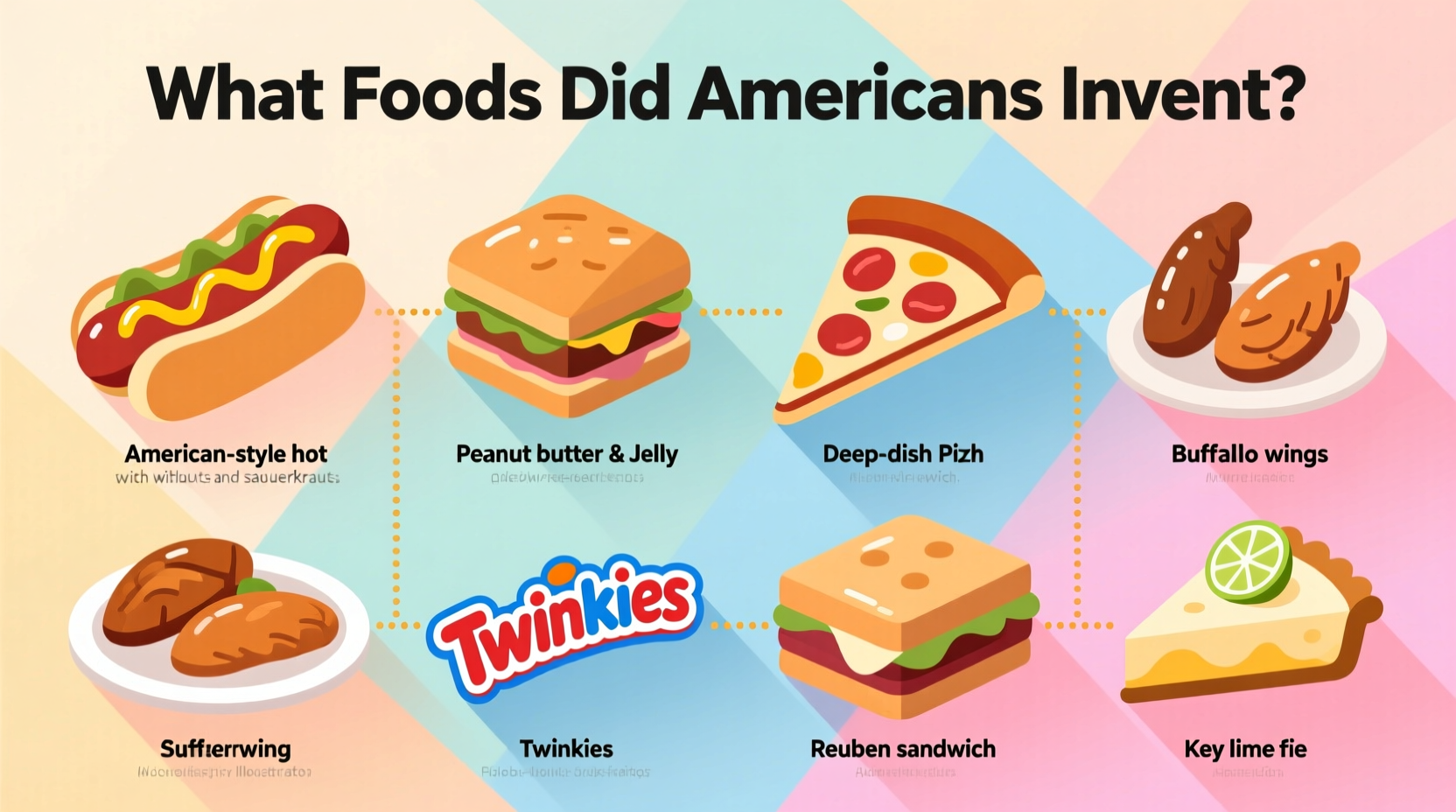The Evolution of American Culinary Innovation
When exploring what foods did Americans actually invent, it's crucial to distinguish between foods merely popularized in America versus those genuinely created here. American food history is a tapestry of cultural exchange, with many 'American' dishes having roots in immigrant traditions. However, certain foods represent true American ingenuity—born from necessity, innovation, and the unique melting pot of cultures that defines the United States.
American Food Inventions Timeline
Understanding American food inventions requires examining their historical context. The following timeline reveals how American innovation evolved alongside the nation's development:
| Time Period | Key Inventions | Social Context |
|---|---|---|
| 1890s-1900s | Peanut butter, cotton candy, ice cream cone | Industrial Revolution enables mass food production |
| Early 1900s | Hamburger, hot dog (as we know them) | Urbanization and street food culture grows |
| 1920s-1930s | Chocolate chip cookie, TV dinner concept | Post-war prosperity and convenience culture |
| Mid-20th Century | Fortune cookies (popularized), cake mix | Suburban expansion and processed foods |
Authentic American Food Inventions: Beyond the Myths
Many foods commonly thought to be American actually have foreign origins. The Library of Congress documents how American food culture absorbed and transformed global traditions. True American inventions typically emerged from specific historical circumstances:
Chocolate Chip Cookies: An Accidental American Classic
Ruth Wakefield's 1930 invention at the Toll House Inn in Massachusetts wasn't planned. When she ran out of baker's chocolate for her cookies, she substituted broken Nestlé semi-sweet chocolate pieces, expecting them to melt into the dough. Instead, they held their shape, creating the chocolate chip cookie. Nestlé soon struck a deal with Wakefield, printing her recipe on chocolate bars, launching one of America's most beloved treats. The National Confectioners Association confirms this origin story through historical records.
Cotton Candy: From Pharmaceutical Innovation to Fairground Treat
While spun sugar existed for centuries, the machine-made version we know as cotton candy was patented in 1897 by William Morrison and John C. Wharton, two confectioners from Nashville. Their invention, originally called "Fairy Floss," debuted at the 1904 St. Louis World's Fair, where it sold approximately 68,655 boxes at 25 cents each (nearly $9 per box today). The Smithsonian National Museum of American History documents this as a genuine American food technology innovation.

The American Hamburger: More Complex Than You Think
The hamburger's origin is surprisingly contested. While ground meat sandwiches existed globally, the American version emerged in the late 19th century. The Library of Congress identifies several claimants:
- Oscar Bilby of Tulsa, Oklahoma served the first documented ground beef patty on a bun in 1891
- Louise and Charles Raffel popularized the "hamburger sandwich" at their New Haven, Connecticut lunch wagon in 1895
- The 1904 St. Louis World's Fair helped spread the concept nationally
What makes the hamburger distinctly American isn't just the concept, but how it evolved into a cultural phenomenon through diners, fast food chains, and regional variations across the United States.
Common Misconceptions About American Food Origins
Many foods commonly believed to be American actually have different origins. This fact comparison clarifies common misconceptions:
| Frequently Misattributed to America | Actual Origin | How It Became Associated with America |
|---|---|---|
| Apple Pie | England/Middle East | "As American as apple pie" slogan popularized during WWII |
| French Fries | Belgium | American soldiers encountered them in Belgium during WWI |
| Fortune Cookies | Japan/California | Popularized in American Chinese restaurants |
| Pizza | Italy | Transformed by Italian immigrants in American cities |
What Qualifies as a True American Food Invention
For a food to qualify as genuinely American-invented, it typically meets one or more of these criteria:
- First documented creation in the United States with verifiable historical records
- Significant transformation of an existing concept into something distinctly new
- Developed using American technology or ingredients not available elsewhere
- Cultural integration that created a new food tradition uniquely American
The National Museum of American History emphasizes that American food innovation often stems from practical needs—preserving food, creating convenience, or adapting to new environments—rather than purely culinary experimentation.
Other Notable American Food Inventions
Beyond the most famous examples, several other foods represent genuine American innovation:
Ice Cream Cones: A World's Fair Necessity
While ice cream existed for centuries, the edible cone was reportedly invented at the 1904 St. Louis World's Fair when an ice cream vendor ran out of dishes. According to Smithsonian records, Syrian immigrant Ernest A. Hamwi rolled waffle-like pastries into cones to help his neighbor, an ice cream vendor. This improvisation became an instant hit, with over 20,000 cones sold during the fair.
Peanut Butter: From Medical Food to American Staple
Though ground peanuts existed in ancient civilizations, modern peanut butter was developed in the 1890s by American physicians seeking a protein source for toothless patients. Dr. John Harvey Kellogg patented a process for making peanut butter in 1895, initially as a health food. By the 1920s, it became a mainstream American food, particularly after Peter Pan introduced the first commercial peanut butter in 1922.
Why American Food Inventions Matter Today
Understanding what foods Americans actually invented provides valuable context for contemporary food culture. These innovations reflect American values of convenience, entrepreneurship, and cultural fusion. The National Archives documents how American food patents and culinary innovations have influenced global eating habits, with many American-invented foods now considered international staples.
Experiencing Authentic American Food History
To truly appreciate these American food inventions, consider:
- Visiting the National Confectioners Association museum exhibits
- Trying original recipes at historic restaurants like Boston's Durgin-Park (est. 1827)
- Exploring regional variations of American classics across different states
- Learning about the immigrant influences that shaped each invention











 浙公网安备
33010002000092号
浙公网安备
33010002000092号 浙B2-20120091-4
浙B2-20120091-4